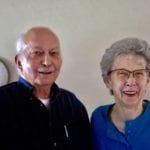Freedom, Friends, Faith: What Today’s Seniors Are Looking For in a Retirement Community
This news story was originally printed in The Oklahoman.

The Kietzmans live at Concordia Senior Life Community. Photo provided.
On a fall day in 1951, when Charles and Katherine Kietzman were married, they made great plans for their future and growing old together. More than forty years later, they were ready to realize their retirement plans.
“We were in Claremore, Oklahoma, and that’s where we were going to be,” Katherine recalled.
They had lived in the community for more than 20 years, but an unexpected turn in Katherine’s health caused them to rethink their plans. Their two daughters live out-of-state and their son was nearly three hours away in Oklahoma City. They began considering options closer to family, and knew access to quality care would become increasingly important as they got older.
Today they live in a patio home at Concordia Life Care Community in Oklahoma City, near their son and grandchildren.
“This wasn’t in our plans but if you get to thinking that you are of age, it was the right thing to do,” she said.
Living in a stand-alone patio home surrounded by peers, the Kietzmans have embraced their new home.
Concordia offers residents several independent living options including patio homes as well as one- and two-bedroom apartments. As more assistance becomes necessary, they can transition into additional levels of care as needed including assisted living, memory care, skilled nursing and long-term care.
The Kietzman’s neighborhood looks much like any other neighborhood in Oklahoma City, except that it is part of a secure division designed especially for seniors.
Katherine enjoys the convenience the community offers. They can cook at home or eat meals in the dining room in the main building, participate in activities and take advantage of health and wellness programs.
“In the four and a half years that we’ve been here, I probably cooked three dishes,” she said. “The housekeeper comes and helps take care of things, but if I don’t want her here, like last week, I just make a call,” Katherine said.
They were able to customize their home to fit their taste and needs.
“It’s our house,” Katherine said.
Their cottage has two bedrooms, two baths, a living room, full kitchen and a lovely sunroom. They also have a garage.
Charles, a World War II veteran, has claimed the sunroom as his quarters, displaying a wonderful collection of memorabilia from his time in the U.S. Airforce.
While Charles admits he still misses his large wood workshop in Claremore, he found a place to get creative in his garage, making wooden toys for his grandchildren.
Charles stays busy with woodworking and other activities around the house. He still mows his own lawn.
“There comes a time – I don’t want to admit it – when I don’t want to do it anymore. Then somebody else would mow,” he said.
Charles initially wasn’t sure that life in a senior community was for him. However, he has since changed his mind.
“It turned out to be very nice. We miss some of the people we knew in Claremore, but we reconnected with others here,” he said. “We are happy.”
Charles and Katherine also said it is good to know Concordia is run by a faith-based organization rather than a large corporation, making everything feel more personal.
Katherine said the freedom of living on their terms has a lot of value.
“You are by yourself, but you are not by yourself,” Katherine said.
Thinking ahead
For many people the question “what do I want getting older to look like?” is included in their retirement planning. Others avoid thinking about it until the time comes.
Yet, most people cite independence as a primary objective.
“Independence sounds great as long as people remain healthy and can care for themselves,” said Julie Davis, marketing director at Concordia. “We have seen Baby Boomers being more proactive. Instead of waiting for their kids to say ‘Dad, we noticed you have trouble getting around,’ they want to start that conversation.”
People begin planning earlier so they can have the lifestyle they envision. Healthy seniors make the decision to downsize their current living situation and transition into a continuing care retirement community because of the ease of maintenance-free living, services and amenities such as housekeeping, dining services, scheduled local transportation, a wide variety of opportunities for socialization, educational, spiritual, and wellness activities; and the availability of quality on-site continuing health care options if ever needed.
Having dealt with one set of aging parents’ health issues, including nursing home placement when their parents could no longer live on their own, and husband and wife ultimately having to be separated due to different healthcare needs, Gilbert and Paula Santillan became aware of the need to do some future planning.
“We began looking at various options for where and how to live the next portion of our lives,” Gilbert said.
As a couple in their 60s with no children and all family located on the West Coast, staying in their large two-story home was not going to work forever.
“We looked into 55+ communities, resort living and high-rise senior apartments, but none of those addressed the issue of healthcare,” she said. “While we don’t currently need assistance, we realize it’s inevitable and time passes very quickly.”
In doing research, the Santillans discovered the continuing care retirement community concept. They attended a Lunch & Learn session at Concordia.
“We learned a lot that day,” Paula said. “It actually was possible for us to ‘buy ourselves a family’ -something we’d joked about – that would be there for us, provide whatever care we needed for as long as we needed it, and allow us to stay together.”
They also learned that one monthly fee would include many services, allowing them to live maintenance free.
“And most importantly, we could decide together about the size, type and location of our new residence, as well as make new friends together, instead of waiting for a catastrophe to strike one of us and leave the other to do all of this alone,” Paula said.
They toured a number of communities and are considering Concordia, among others.
What is a continuing care retirement community?
Danny Eischen, CEO and executive director at Concordia Life Plan Community, said a continuing care community offers a full spectrum of continuing health care services in addition to independent living. The community includes assisted living, specialized memory care, rehabilitation and long-term nursing care, should health care needs change.
“At Concordia, we present a level of comfort for both you and your loved ones to help take the stress out of future health care needs,” Eischen said.
The community also offers amenities and services for residents, from general housekeeping and yard work to planned events or outings. It offers a way to stay active and engaged in life while living within a supportive and caring community atmosphere.
“A community like Concordia offers peace of mind for you and your loved ones. You’ll know that your future is secure and that you will receive the correct level of care, no matter what your future needs are,” he said.
Eischen explained that not all continuing care retirement communities offer the same services at the same price. While some communities may have additional levels of care on-site, you pay for those services out of pocket, a Life Care community like Concordia allows residents guaranteed access to higher levels of care if needed, at a manageable and predictable cost.
This type of care allows people to enjoy life to its fullest, knowing a safety net of care and services are in place for them.
For more information, visit www.concordiaseniorliving.com/.

